FEM Simulation and Verification of Brazing SiC Ceramic with Novel Zr-Cu Filler Metal
Abstract
1. Introduction
2. FEM Simulation and Experiment Methods
2.1. FEM Simulation of Brazing SiC Ceramic Joint
2.2. Brazing Experiment and Evaluation
3. Results and Discussion
3.1. Von Mises Stress of the FEM Simulation Joint
3.2. The Influence of Filler Metal Thickness on Axial Stress of Joint
3.3. The Effect of Different Cooling Rates on the Axial Stress of Joint
3.4. Verification of FEM Simulation
4. Conclusions
Author Contributions
Funding
Acknowledgments
Conflicts of Interest
References
- Huang, Y.H.; Jiang, D.L.; Zhang, X.F. Enhancing toughness and strength of SiC ceramics with reduced graphene oxide by HP sintering. J. Eur. Ceram. Soc. 2018, 38, 4329–4337. [Google Scholar] [CrossRef]
- Yu, Y.; Dong, H.Y.; Ma, B. Effect of different filler materials on the microstructure and mechanical properties of SiC/SiC joints joined by spark plasma sintering. J. Alloy. Compd. 2017, 708, 373–379. [Google Scholar] [CrossRef]
- Katoh, Y.; Snead, L.L.; Henager, C.H. Current status and recent research achievements in SiC/SiC composites. J. Nucl. Mater. 2014, 455, 387–397. [Google Scholar] [CrossRef]
- Zhou, B.F.; Feng, K.Q. Zr-Cu alloy filler metal for brazing SiC ceramic. RSC Adv. 2018, 8, 26251–26254. [Google Scholar] [CrossRef]
- Tian, X.Y.; Feng, J.C.; Shi, J.M. Brazing of ZrB2–SiC–C ceramic and GH99 superalloy to form reticular seam with low residual stress. Ceram. Int. 2015, 41, 145–153. [Google Scholar] [CrossRef]
- Lu, Y.; Zhang, X.; Chu, J. Study on active reactive brazing of C/SiC ceramic to Nb alloy. Chin. J. Rare Met. 2008, 32, 636–640. [Google Scholar]
- Chen, Y.; Cui, H.; Lu, B.; Lu, F. The microstructural evolution of vacuum brazed 1Cr18Ni9Ti using various filler metals. Materials 2017, 10, 385. [Google Scholar] [CrossRef] [PubMed]
- Withers, P.J.; Bhadeshia, H.K.D.H. Residual stress part 1: measurement techniques. Mater. Sci. Technol. 2001, 17, 355–365. [Google Scholar] [CrossRef]
- Acevedo, C.; Drezet, J.M.; Lefebvre, J.P. Residual stresses in as-welded joints: finite element modeling and neutron difraction stress measurements. Key Eng. Mater. 2012, 488–489, 335–338. [Google Scholar] [CrossRef]
- Mackerle, J. Review of pre- and postprocessor programs included in the major commercial general purpose finite element packages. Adv. Eng. Softw. 1983, 5, 43–53. [Google Scholar] [CrossRef]
- Anzalone, R.; Arrigo, G.; Camarda, M. Advanced residual stress analysis and FEM simulation on heteroepitaxial 3C–SiC for mems application. J. Microelectromechanical Syst. 2011, 20, 745–752. [Google Scholar] [CrossRef]
- Meng, Z.B. Welding residual stress of K-joint and its influence on stress concentration factor. J. China Univ. Pet. 2013, 37, 130–134. [Google Scholar]
- Tseng, H.K.; Wu, M.L. Electro-thermal-mechanical modeling of wire bonding failures in IGBT. In Proceedings of the 2013 8th International Microsystems, Packaging, Assembly and Circuits Technology Conference (IMPACT), Taipei, Taiwan, 22–25 October 2013. [Google Scholar]
- Zhong, Z.; Hou, G.; Zhu, Z. Microstructure and mechanical strength of SiC joints brazed with Cr3C2 particulate reinforced Ag-Cu-Ti brazing alloy. Ceram. Int. 2018, 44, 11862–11868. [Google Scholar] [CrossRef]
- Dai, X.Y.; Cao, J.; Tian, Y.T. Effect of holding time on microstructure and mechanical properties of SiC/SiC joints brazed by Ag-Cu-Ti+B4C composite filler. Mater. Charact. 2016, 118, 294–301. [Google Scholar] [CrossRef]
- Xu, L.; Huang, C.Z.; Liu, H.I. Study on the synthesis and growth mechanisms of the refractory ZrC whiskers. Int. J. Refract. Met. Hard Mater. 2014, 42, 116–119. [Google Scholar] [CrossRef]
- Yeom, H.; Lockhart, C.; Mariani, R. Evaluation of steam corrosion and water quenching behavior of zirconium-silicide coated LWR fuel claddings. J. Nucl. Mater. 2018, 499, 256–267. [Google Scholar] [CrossRef]
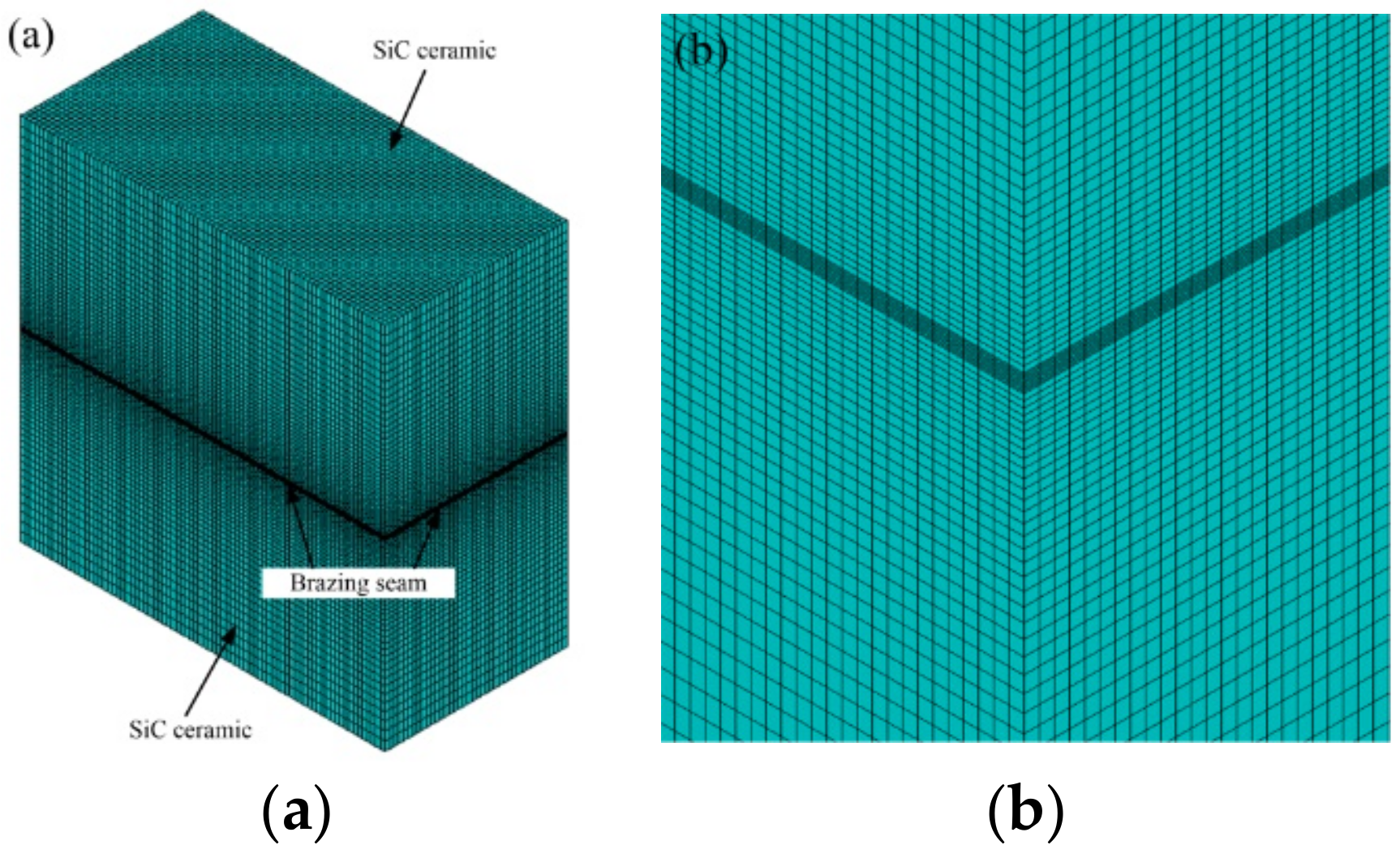


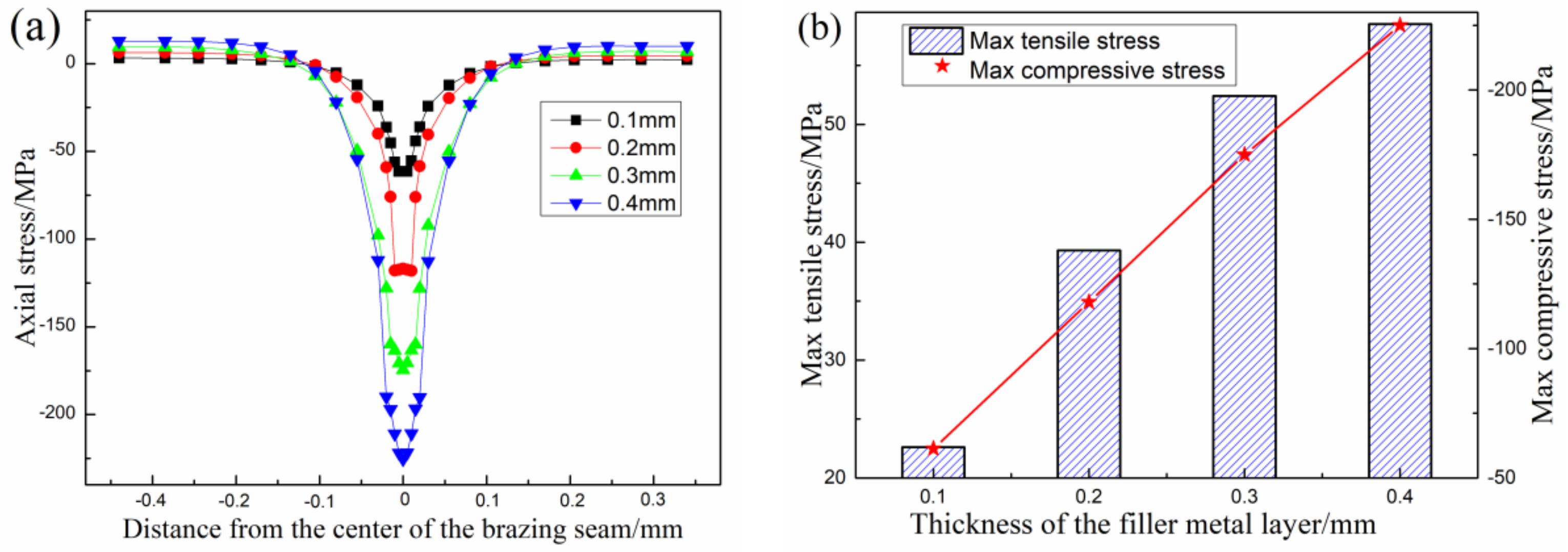
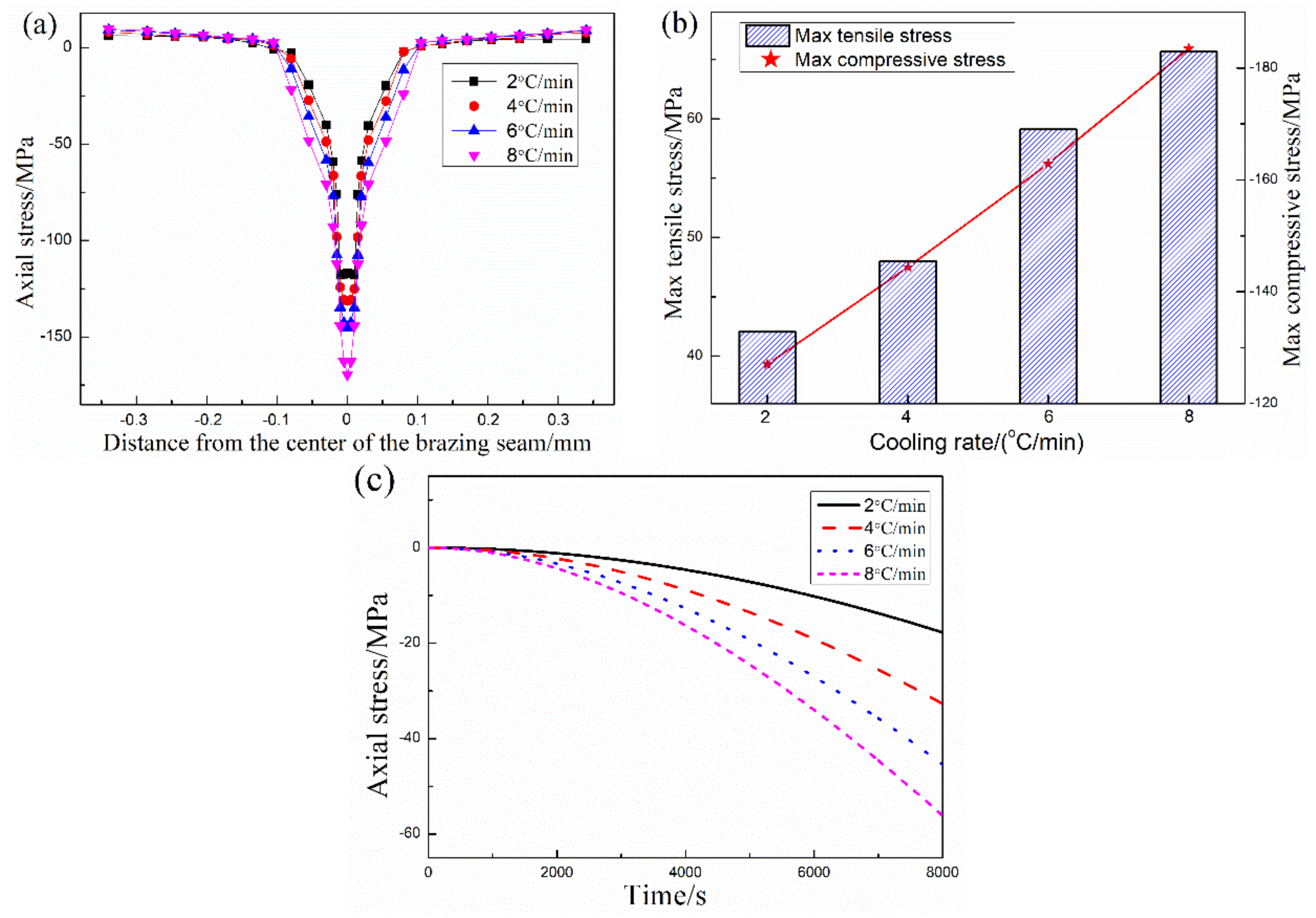
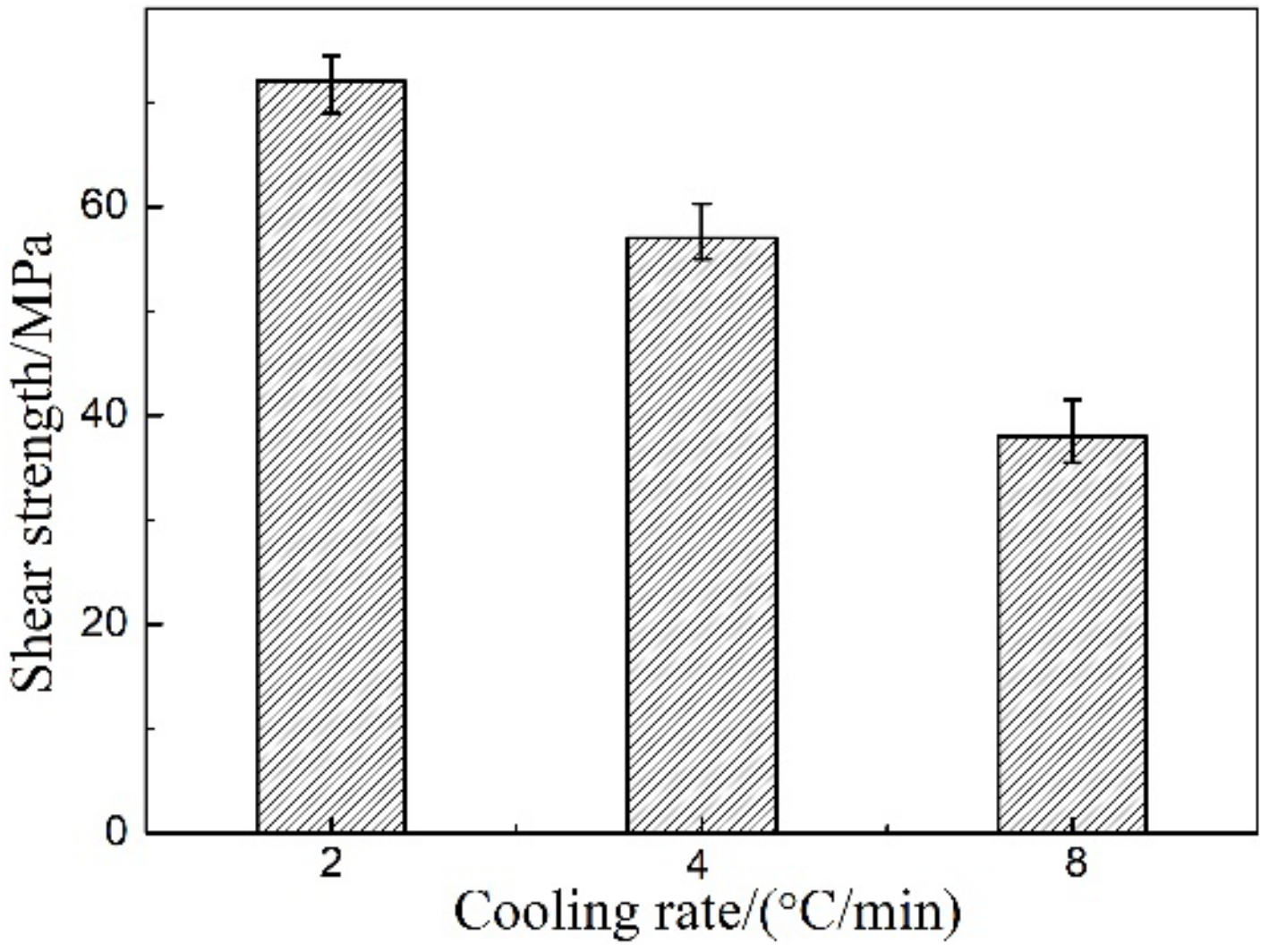
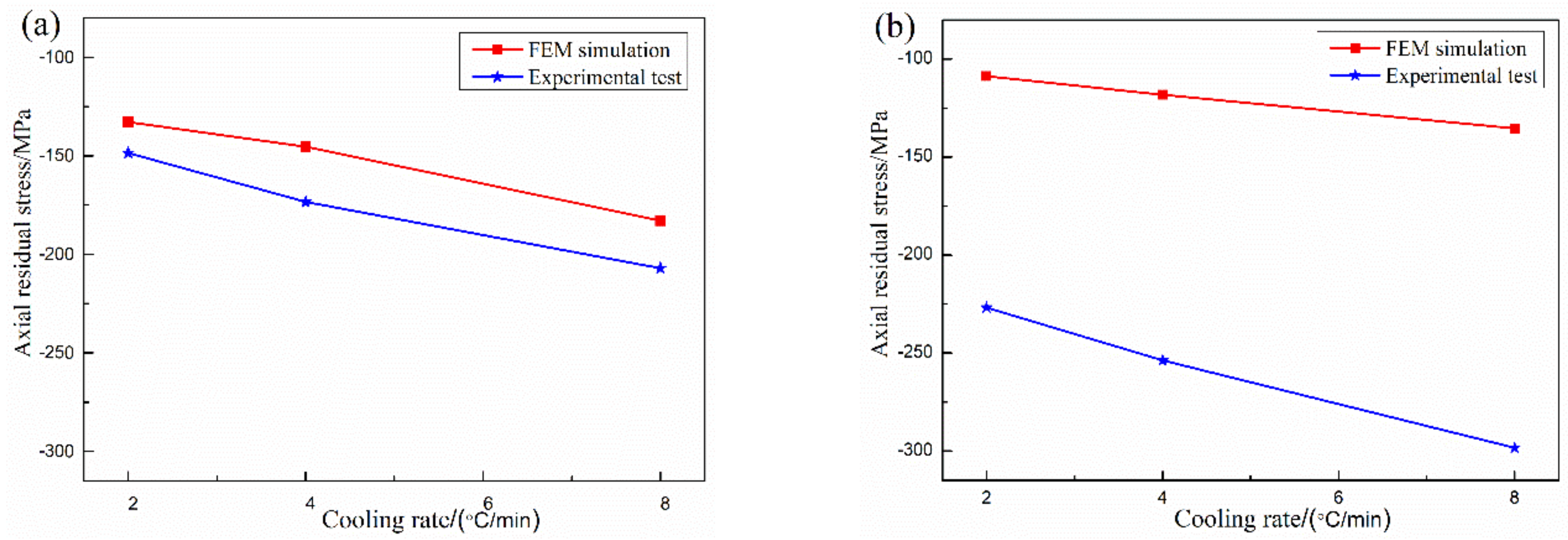
| Materials | T (K) | E (GPa) | A (10−6/K) | σs (MPa) | Λ (W/m/K) | c (J/kgK) | Ρ (kg/m3) | ν |
|---|---|---|---|---|---|---|---|---|
| SiC | 293 | 330 | 4.5 | - | 28.6 | 670 | 3120 | 0.19 |
| 473 | 326 | 4.8 | - | 32.8 | 813 | 3120 | 0.19 | |
| 673 | 318 | 5.2 | - | 37.1 | 1088 | 3120 | 0.19 | |
| 873 | 309 | 5.5 | - | 41.7 | 1173 | 3120 | 0.19 | |
| 973 | 302 | 5.6 | - | 43.4 | 1202 | 3120 | 0.19 | |
| 1073 | 291 | 5.9 | - | 45.2 | 1227 | 3120 | 0.19 | |
| Filler metal | 293 | 117 | 7.4 | 398 | 329 | 280 | 6690 | 0.33 |
| 473 | 114 | 7.5 | 382 | 391 | 426 | 6690 | 0.33 | |
| 673 | 105 | 7.7 | 363 | 45.8 | 542 | 6690 | 0.33 | |
| 873 | 99 | 8.1 | 304 | 52.6 | 667 | 6690 | 0.33 | |
| 973 | 92 | 8.7 | 236 | 58.7 | 734 | 6690 | 0.33 | |
| 1073 | 76 | 12.9 | 128 | 65.4 | 792 | 6690 | 0.33 |
| Properties | Maximum Temperature of Application | Density | Open Porosity | Bending Strength | Modulus of Elasticity | Thermal Conductivity | Coefficient of Thermal Expansion |
|---|---|---|---|---|---|---|---|
| RBSiC | 1380 °C | >3.02 g/cm3 | <0.1% | 280 MPa | 300 GPa | 74 W/mK | 4.5 × 10−6 K−1 |
© 2019 by the authors. Licensee MDPI, Basel, Switzerland. This article is an open access article distributed under the terms and conditions of the Creative Commons Attribution (CC BY) license (http://creativecommons.org/licenses/by/4.0/).
Share and Cite
Zhou, B.; Zeng, Z.; Cai, Y.; Feng, K. FEM Simulation and Verification of Brazing SiC Ceramic with Novel Zr-Cu Filler Metal. Materials 2019, 12, 3380. https://doi.org/10.3390/ma12203380
Zhou B, Zeng Z, Cai Y, Feng K. FEM Simulation and Verification of Brazing SiC Ceramic with Novel Zr-Cu Filler Metal. Materials. 2019; 12(20):3380. https://doi.org/10.3390/ma12203380
Chicago/Turabian StyleZhou, Bofang, Zhichen Zeng, Yuchen Cai, and Keqin Feng. 2019. "FEM Simulation and Verification of Brazing SiC Ceramic with Novel Zr-Cu Filler Metal" Materials 12, no. 20: 3380. https://doi.org/10.3390/ma12203380
APA StyleZhou, B., Zeng, Z., Cai, Y., & Feng, K. (2019). FEM Simulation and Verification of Brazing SiC Ceramic with Novel Zr-Cu Filler Metal. Materials, 12(20), 3380. https://doi.org/10.3390/ma12203380





